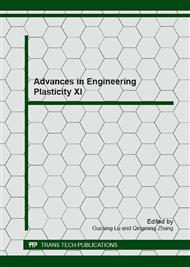[1]
METAFOR, home made Finite Element Code http: /www. ltas-mnl. ulg. ac. be/dokuwiki/doku. php?id=metafor: start.
Google Scholar
[2]
Jeunechamps P. -P. and Ponthot J. -P., An efficient implicit approach for the thermomechanical behavior of materials submitted to high strain rates, J. de Phys. IV, Vol. 134, 2006, pp.515-520.
DOI: 10.1051/jp4:2006134079
Google Scholar
[3]
Belytschko T. and Lin J. A 3D impact penetration algorithm with erosion, Comp. & Structures, 25 (1987), 95-104.
Google Scholar
[4]
Børvik T., Hopperstad O., Dey S., Pizzinato E., Langseth M. and Albertini C., Strength and ductility of Weldox 460 E steel at high strain rates, elevated temperatures and various stress triaxialities, Engineering Fractures Mechanics, Vol. 72, 2005, pp.1071-1087.
DOI: 10.1016/j.engfracmech.2004.07.007
Google Scholar
[5]
Armero F. and Simo J., A new unconditionally stable fractional step method for non-linear coupled thermomechanical problems, Int. J. Numer. Methods Engrg., 35 (1992), 737-766.
DOI: 10.1002/nme.1620350408
Google Scholar
[6]
Chung J. and Hulbert G., A time integration algorithms for structural dynamics with improved numerical dissipations: the generalized-α method, J. of Applied Mech. 60 (1993), 371-375.
DOI: 10.1115/1.2900803
Google Scholar
[7]
Mediavilla J. and Peerlings R. and Geers M., A Robust and Consistent Remeshing-Transfer Operator for Ductile Fracture Simulations, Computers & Structures, 84 (2006), 604-623.
DOI: 10.1016/j.compstruc.2005.10.007
Google Scholar
[8]
Johnson, G. and Cook, W., 1985. Fracture characteristics of three metals subjected to various strains, strain rates, temperatures, and pressures, Eng. Fracture Mechanics, Vol. 21, pp.31-48.
DOI: 10.1016/0013-7944(85)90052-9
Google Scholar


